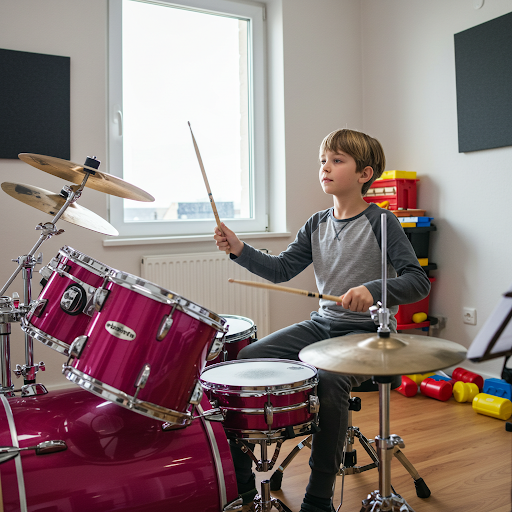Your cart is currently empty!
Eleven reasons why the age between 5 and 10 years old is perfect to begin learning drums

While musical exploration can begin at any age, the period between 5 and 10 years old presents a unique window of opportunity that makes it an exceptionally advantageous time to start learning the drums. Here’s why this age range hits the perfect beat for aspiring rockers:
Physical development:
- Developing coordination: at this age, children are rapidly developing their gross and fine motor skills, crucial for coordinating limbs and executing drum patterns. Learning drums actively enhances this development.
- Growing strength and stamina: while not requiring immense strength initially, playing drums helps build physical endurance and control over limb movements, setting a solid foundation for more complex rhythms later.
- Hand-eye coordination: the act of seeing a beat and striking the drum simultaneously significantly improves hand-eye coordination, a skill that benefits various other aspects of life.
Cognitive development:
- Rhythm recognition: young children are naturally drawn to rhythm and often respond instinctively to music. This innate inclination makes them highly receptive to learning basic rhythmic patterns on the drums.
- Pattern recognition and memory: learning drum beats involves recognizing and memorizing patterns, which strengthens cognitive skills related to sequencing and recall.
- Auditory processing: paying attention to the sounds produced and differentiating between rhythms hones auditory processing skills, enhancing their ability to discern and interpret musical cues.
Emotional and social development:
- Fun and engagement: drums are inherently engaging and offer a physically active way for children to express themselves and release energy, making learning feel less like a chore and more like play.
- Building confidence: mastering even simple beats can provide a significant boost to a child’s self-esteem and sense of accomplishment.
- Social opportunities: as they progress, learning drums can open doors to playing in school bands or with peers, fostering teamwork and social interaction.
Other factors:
- Malleability and adaptability: younger learners are generally more open to new ideas and less likely to have ingrained habits that might hinder learning proper technique.
- Long-term musical foundation: starting early provides a substantial head start in developing a strong sense of rhythm and timing, fundamental skills that can benefit the learning of other instruments in the future.
In conclusion, the years between 5 and 10 offer a potent combination of physical readiness, cognitive receptivity, and emotional enthusiasm that creates an ideal environment for children to begin their rhythmic journey with the drums. This early start can lay the groundwork for a lifelong appreciation and mastery of music.

Leave a Reply